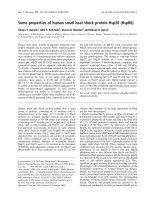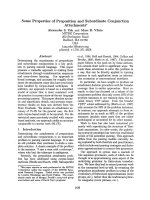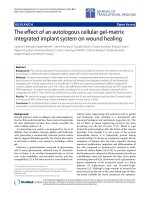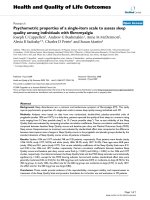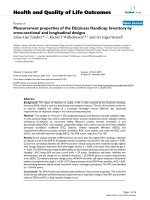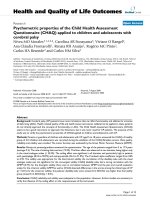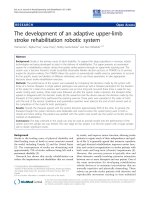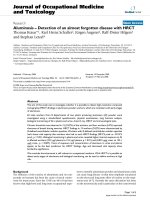Báo cáo toán học: " Some properties of an integral operator defined by convolution" potx
Bạn đang xem bản rút gọn của tài liệu. Xem và tải ngay bản đầy đủ của tài liệu tại đây (154.65 KB, 13 trang )
This Provisional PDF corresponds to the article as it appeared upon acceptance. Fully formatted
PDF and full text (HTML) versions will be made available soon.
Some properties of an integral operator defined by convolution
Journal of Inequalities and Applications 2012, 2012:13 doi:10.1186/1029-242X-2012-13
Muhammad Arif ()
Khalida Inayat Noor ()
Fazal Ghani ()
ISSN 1029-242X
Article type Research
Submission date 15 September 2011
Acceptance date 19 January 2012
Publication date 19 January 2012
Article URL />This peer-reviewed article was published immediately upon acceptance. It can be downloaded,
printed and distributed freely for any purposes (see copyright notice below).
For information about publishing your research in Journal of Inequalities and Applications go to
/>For information about other SpringerOpen publications go to
Journal of Inequalities and
Applications
© 2012 Arif et al. ; licensee Springer.
This is an open access article distributed under the terms of the Creative Commons Attribution License ( />which permits unrestricted use, distribution, and reproduction in any medium, provided the original work is properly cited.
1
Some properties of an integral operator defined by convolution
Muhammad Arif
*1
, Khalida Inayat Noor
2
and Fazal Ghani
1
1
Department of Mathematics, Abdul Wali Khan University, Mardan, Pakistan
2
Department of Mathematics, COMSATS Institute of Information Technology,
Islamabad, Pakistan
*
Corresponding author:
E-mail addresses:
KIN:
FG:
Abstract
In this investigation, motivated from Breaz study, we introduce a new family of integral operator
using famous convolution technique. We also apply this newly defined operator for investigating
some interesting mapping properties of certain subclasses of analytic and univalent functions.
2010 Mathematics Subject Classification: 30C45; 30C10.
Keywords: close-to-convex functions; convolution; integral operators.
2
1. Introduction
Let
A
denote the class of analytic function satisfying the condition
(
)
(
)
0 0 1 0
f f
′
= − =
in the
open unit disc
{
}
: 1 .
z z
= <
U
By
* *
, , , ,
S C S C
and
K
we means the well-known subclasses of
A
which consist of univalent, convex, starlike, quasi-convex, and close-to-convex functions,
respectively. The well-known Alexander-type relation holds between the classes
*
and ,
C S
and
*
and ,
C K
that is,
(
)
(
)
*
,
f z C zf z S
′
∈ ⇔ ∈
and
(
)
(
)
*
.
f z C zf z K
′
∈ ⇔ ∈
It was proved in [1] that a locally univalent function
(
)
f z
is close-to-convex, if and only if
(
)
( )
2
1
Re 1 , ,
(1.1)
i
zf z
d z re
f z
θ
θ
θ
θ π
′′
+ > − =
′
∫
for each
(
)
0,1
r ∈ and every pair
1 2
,
θ θ
with
1 2
0 2 .
θ θ π
≤ < ≤
Let
(
)
k
P
ξ
be the class of functions
(
)
p z
analytic in
U
with
(
)
0 1
p
=
and
(
)
2
0
Re
, , 2.
1
i
p z
d k z re k
π
θ
ξ
θ π
ξ
−
≤ = ≥
−
∫
This class was introduced in [2] and for
2, 0,
k
ξ
= =
the class
(
)
k
P
ξ
reduces to the class P of
functions with positive real part. We consider the following classes:
3
( ) ( )
(
)
( )
( )
( ) ( ) ( )
( )
( )
( )
: ,
: : , .
k k
k k
zf z
R f z A P z
f z
f z
T f z A g z C P z
g z
ξ ξ
ξ ξ
′
= ∈ ∈ ∈
′
= ∈ ∃ ∈ ∈ ∈
′
U
U
These classes were studied by Noor [3–5] and Padmanabhan and Parvatham [2]. Also it can
easily be seen that
(
)
*
2
0
R S
=
and
(
)
2
0 ,
T K
= where
*
S
and
K
are the well-known classes of
starlike and close-to-convex functions.
Using the same method as that of Kaplan [1], Noor [6] extend the result of Kaplan given in (1.1),
and proved that a locally univalent function
(
)
f z
is in the class
,
k
T
if and only if
(
)
( )
2
1
Re 1 , ,
(1.2)
2
i
zf z
k
d z re
f z
θ
θ
θ
θ π
′′
+ > − =
′
∫
for each
(
)
0,1
r ∈ and every pair
1 2
,
θ θ
with
1 2
0 2 .
θ θ π
≤ < ≤
For any two analytic functions
( ) ( ) ( )
0 0
and g , ,
n n
n n
n n
f z a z z b z z
∞ ∞
= =
= = ∈
∑ ∑
U
the convolution (Hadamard product) of
(
)
f z
and
(
)
g z
is defined by
( ) ( ) ( )
0
g , .
n
n n
n
f z z a b z z
∞
=
∗ = ∈
∑
U
Using the techniques from convolution theory many authors generalized Breaz operator in
several directions, see [7, 8] for example. Here, we introduce a generalized integral operator
(
)
(
)
, , :
n
n i i i
I f g h z A A
→ as follows
4
( )( ) ( ) ( )
( )
( )
( )
1
0
, , , 1.3
i
i
z
n
i
n i i i i i
i
h t
I f g h z f t g t dt
t
β
α
=
′
= ∗
∏
∫
where
(
)
(
)
(
)
, ,
i i i
f z g z h z A
∈
with
(
)
(
)
0
i i
f z g z
∗ ≠
and
, 0
i i
α β
≥
for
1, 2, , .
i n
=
K The
operator
(
)
(
)
, ,
n i i i
I f g h z
reduces to many well-known integral operators by varying the
parameters
,
i i
α β
and by choosing suitable functions instead of
(
)
(
)
, .
i i
f z g z
For example,
(i) If we take
( )
( )
for all 1 ,
1
i
z
g z i n
z
= ≤ ≤
−
we obtain the integral operator
( )( ) ( )
(
)
( )
( )
1
0
, , 1.4
i
i
z
n
i
n i i i
i
h t
I f h z f t dt
t
β
α
=
′
=
∏
∫
introduced in [9].
(ii) If we take
0 and 1 ,
i
i n
α
= ≤ ≤
we obtain the integral
( )( )
( )
1
0
,
i
z
n
i
n i
i
h t
I h z dt
t
β
=
=
∏
∫
introduced and studied by Breaz and Breaz [10].
(iii) If we take
( )
( )
, 0,
1
i i
z
g z
z
β
= =
−
we obtain the integral operator
( )( ) ( )
(
)
1
0
,
i
z
n
n i i
i
I f z f t dt
α
=
′
=
∏
∫
introduced and studied by Breaz et al. [11].
(iv) If we take
1 1
1, 0 and 1
n
α β
= = =
in (1.4), we obtain the Alexander integral operator
5
( )( )
(
)
1
1
0
,
z
n
h t
I h z dt
t
=
∫
introduced in [12].
(v) If we take
1 1
1, 0 and n
α β β
= = =
, we obtain the integral operator
( )( )
( )
1
1
0
,
z
n
h t
I h z dt
t
β
=
∫
studied in [13].
In this article, we study the mapping properties of different subclasses of analytic and univalent
functions under the integral operator given in (1.3). To prove our main results, we need the
following lemmas.
Lemma 1.1 [14]. Let
(
)
(
)
k
f z R
ξ
∈ for
2, 0 1.
k
ξ
≥ ≤ <
Then with
1 2
0 2
θ θ π
≤ < ≤ and
, 1,
i
z re r
θ
= <
(
)
( )
( )
2
1
Re 1 1 .
2
zf z
k
d
f z
θ
θ
θ ξ π
′
> − − −
∫
Lemma 1.2 [15]. If
(
)
f z C
∈
and
(
)
g z K
∈
, then
(
)
(
)
g .
f z z K
∗ ∈
2. Main results
Theorem 2.1. Let
(
)
(
)
(
)
(
)
* *
, and
i i i k
f z S g z C h z R
ξ
∈ ∈ ∈ with
0 1,
ξ
≤ <
2
k
≥
for all
1 .
i n
≤ ≤
If
( ) ( )
1
1 1 1,
2.1
2
n
i i
i
k
α ρ β
=
+ − − ≤
∑
6
then integral operator defined by (1.3) belongs to the class of close-to-convex functions.
Proof. Let
(
)
(
)
* *
and .
i i
f z S g z C
∈ ∈ Then there exists
(
)
i
z C
ϕ
∈
such that
( ) ( )
.
i i
f z z z
ϕ
′
=
Now consider
( ) ( ) ( ) ( ) ( ) ( )
* * * .
i i i i i i
f z g z z z g z z zg z
ϕ ϕ
′ ′
= =
Since
(
)
*
,
i
g z C
∈ then by Alexander-type relation
( )
.
i
zg z K
′
∈ So, by Lemma 1.2, we have
( ) ( )
* ,
i i
z zg z K
ϕ
′
∈
which implies that
(
)
(
)
*
i i
f z g z K
∈
and hence, by using (1.1),
( ) ( )
( )
( ) ( )
( )
2
1
*
Re 1 .
(2.2)
*
i i
i i
z f z g z
d
f z g z
θ
θ
θ π
′′
+ > −
′
∫
From (1.3), we obtain
( ) ( ) ( ) ( )
( )
( )
( )
1
, , . 2.3
i
i
n
i
n i i i i i
i
h z
I f g h z f z g z
z
β
α
=
′
′
= ∗
∏
Differentiating (2.3) logarithmically, we have
( ) ( )
( ) ( )
( ) ( )
( )
( ) ( )
( )
( )
( )
n
1 1
, ,
1 + 1 +1
, ,
n
i i
n i i i i
i i
i i
i
n i i i
i i
z f z g z
I f g h z zh z
h z
I f g h z
f z g z
α β
= =
′′
′′
′
∗
+ = −
′ ′
∗
∑ ∑
7
( ) ( )
( )
( ) ( )
( )
( )
( )
( )
n n
1 1 1
1+ + 1 .
n
i i
i
i i i i
i i i
i
i i
z f z g z
zh z
h z
f z g z
α β α β
= = =
′′
′
∗
= + − +
′
∗
∑ ∑ ∑
Taking real part and then integrating with respect to
θ
, we get
( ) ( )
( ) ( )
( ) ( )
( )
( ) ( )
( )
2 2
1 1
1
, ,
Re 1 Re 1+
, ,
n
i i
n i i i
i
i
n i i i
i i
z f z g z
I f g h z
d d
I f g h z
f z g z
θ θ
θ θ
θ α θ
=
′′
′′
∗
+ =
′ ′
∗
∑
∫ ∫
( )
( )
( ) ( )
2
1
n n
2 1
1 1
Re 1 .
i
i i i
i i
i
zh z
d
h z
θ
θ
β θ α β θ θ
= =
′
+ + − + −
∑ ∑
∫
Using (2.2) and Lemma 1.1, we have
( ) ( )
( ) ( )
( )
2
1
1
, ,
Re 1 1 1
2
, ,
n
n i i i
i i
i
n i i i
I f g h z
k
d
I f g h z
θ
θ
θ π α ρ β
=
′′
+ > − + − −
′
∑
∫
( ) ( )
n
2 1
1
1
i i
i
α β θ θ
=
+ − + −
∑
From (2.1), we can easily write
( ) ( )
1 1
1 1 1.
2
n n
i i i i
i i
k
α β α ρ β
= =
+ < + − − ≤
∑ ∑
This implies that
( )
1
1 ,
n
i i
i
α β
=
+ <
∑
so, minimum is for
1 2
,
θ θ
= we obtain
8
( ) ( )
( ) ( )
2
1
, ,
Re 1 ,
, ,
n i i i
n i i i
I f g h z
d
I f g h z
θ
θ
θ π
′′
+ > −
′
∫
and this implies that
(
)
(
)
, , .
n i i i
I f g h z K
∈
For
2
k
=
in Theorem 2.1, we obtain
Corollary 2.3. Let
(
)
(
)
(
)
(
)
* * *
, and
i i i
f z S g z C h z S
ξ
∈ ∈ ∈ with
0 1,
ξ
≤ <
for all
1 .
i n
≤ ≤
If
1
1,
n
i
i
α
=
≤
∑
then
(
)
(
)
, , .
n i i i
I f g h z K
∈
Theorem 2.4. Let
(
)
(
)
and
i k i k
f z T h z R
∈ ∈
for 1
i n
≤ ≤
. If
, 0
i i
α β
≥
such that
0
i i
α β
+ ≠
and
( ) ( )
1
1,
2.4
2
n
i i i
i
k
α β β
=
+ − ≤
∑
then
(
)
(
)
,
n i i
I f h z
defined by (1.4) belongs to the class of close-to-convex functions.
Proof. From (1.4), we have
( ) ( ) ( )
(
)
( )
( )
1
, . 2.5
i
i
n
i
n i i i
i
h z
I f h z f z
z
β
α
=
′
′
=
∏
Differentiating (2.5) logarithmically, we have
( ) ( )
( ) ( )
( )
( )
( )
( )
( )
n n
1 1 1
,
1 1+ + 1 .
,
n
n i i i i
i i i i
i i i
i
i
n i i
I f h z z f z z h z
h z
f z
I f h z
α β α β
= = =
′′
′′ ′
+ = + − +
′ ′
∑ ∑ ∑
Taking real part and then integrating with respect to
θ
, we get
9
( ) ( )
( ) ( )
( )
( )
( )
( )
2 2 2
1 1 1
n
1 1
,
Re 1 Re 1+ Re
,
n
n i i i i
i i
i i
i
i
n i i
I f h z z f z zh z
d d d
h z
f z
I f h z
θ θ θ
θ θ θ
θ α θ β θ
= =
′′
′′ ′
+ = +
′ ′
∑ ∑
∫ ∫ ∫
( ) ( )
n
2 1
1
1 .
i i
i
α β θ θ
=
+ − + −
∑
( ) ( )
n n
2 1
1 1 1
1 1 ,
2 2
n
i i i i
i i i
k k
π
α π β α β θ θ
= = =
> − − − + − + −
∑ ∑ ∑
where we have used Lemma 1.1 and (1.2)
( ) ( ) ( )
n
2 1
1 1
1 .
2
n
i i i i i
i i
k
α β β α β θ θ
= =
= − + − + − + −
∑ ∑
From (2.4), we can obtain
( )
1
1.
n
i i
i
α β
=
+ <
∑
So minimum is for
1 2
,
θ θ
= thus we have
( ) ( )
( ) ( )
2
1
,
Re 1 .
,
n i i
n i i
I f h z
d
I f h z
θ
θ
θ π
′′
+ > −
′
∫
This implies that
(
)
(
)
, .
n i i
I f h z K
∈
For
2
k
=
in Theorem 2.4, we obtain the following result.
Corollary 2.5. Let
(
)
(
)
*
,
i i
f z K h z S
∈ ∈
for 1
i n
≤ ≤
and
( )
1
1,
2
n
i i i
i
k
α β β
=
+ − ≤
∑
10
then
(
)
(
)
,
n i i
I f h z
defined by (1.4) belongs to the class of close-to-convex functions.
Competing interests
The authors declare that they have no competing interests.
Authors’ contributions
MA completed the main part of this article, KIN presented the ideas of this article, FG
participated in some results of this article. MA made the text file and all the communications
regarding the manuscript. All authors read and approved the final manuscript.
Acknowledgments
The authors would like to thank the reviewers and editor for improving the presentation of this
article, and they also thank Dr. Ihsan Ali, Vice Chancellor AWKUM, for providing excellent
research facilities in AWKUM.
References
[1]. Kaplan, W: Close-to-convex Schlicht functions. Michigan J. Math. 1, 169–185 (1952)
11
[2]. Padmanabhan, K, Parvatham, R: Properties of a class of functions with bounded
boundary rotation. Ann. Polon. Math. 31, 311–323 (1975)
[3]. Noor, KI: On radii of convexity and starlikeness of some classes of analytic functions.
Int. J. Math. Math. Sci. 14(4), 741–746 (1991)
[4]. Noor, KI: On some integral operators for certain families of analytic function. Tamkang
J. Math. 22, 113–117 (1991)
[5]. Noor, KI, Haq W, Arif M, Mustafa S: On bounded boundary and bounded radius
rotations. J. Inequal. Appl. 2009. Article ID 813687, 12 (2009)
[6]. Noor, KI: On generalization of close-to-convexity. Int. J. Math. Math. Sci. 15(2), 279–
290 (1992)
[7]. Bulut, S: A new general integral operator defined by Al-Oboudi differential operator. J.
Inequal. Appl. 2009, Article ID 158408, 13 (2009)
[8]. Vijayvargy, L, Goswami, P, Malik, B: On some integral operators for certain classes of
P-valent functions. Int. J. Math. Math. Sci. 2011, Article ID 783084, 10 (2011)
[9]. Frasin, BA: Order of convexity and univalency of general integral operator. J. Franklin
Inst. 348(6), 1013–1019 (2011)
[10]. Breaz, D, Breaz, N: Two integral operator. Studia Universitatis Babes-Bolyai,
Mathematica, Clunj-Napoca 3, 13–19 (2002)
[11]. Breaz, D, Owa, S, Breaz, N: A new integral univalent operator. Acta Univ. Apulensis
Math. Inf. 16, 11–16 (2008)
12
[12]. Alexander, JW: Functions which map the interior of the unit circle upon simple regions.
Ann. Math. 17, 12–22 (1915–1916)
[13]. Miller, SS, Mocanu, PT, Read, MO: Starlike integral operators. Pacific J. Math. 79,
157–168 (1978)
[14]. Noor, KI: On subclasses of close-to-convex functions of higher order. Int. J. Math.
Math. Sci. 6(2), 327–334 (1983)
[15]. Ruscheweyh, S, Sheil-Small, T: Hademard product s of Schlicht functions and the
Polya-Schoenberg conjecture. Comment. Math. Helv. 48, 119–135 (1973)
